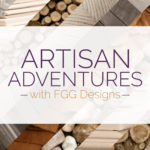
 Listen to the Podcast
Listen to the Podcast
Click play to listen to our full episode or to automatically receive future podcast releases, subscribe to us on iTunes!
Below is a quick summary of what was discussed plus any resources we may have mentioned.
Show Notes
In today’s episode, we will be talking about Shaun’s spoon carving tool kit. Shaun is going to talk through his toolkit and give some recommendations and tips on finding the best tools for you.
First up, let’s discuss the difference between what we call modern tools, as opposed to traditional tools. The modern way of carving would be to use power tools, whereas the way Shaun carves uses the traditional method of using an ax and knives. So let’s looks now at his first tool – the ax.
The Ax
Whether it would be a spoon, spatula, or anything else, the ax is the first tool Shaun reaches for. With this tool, he splits the log in half and wastes away (removes) as much of the bulk material as possible. Shaun uses (and recommends) the carving ax by Robin Wood, an English bowl turner and blacksmith. The size, shape, and weight of this ax makes it ideal for carving. The shape of the handle allows you to get big, powerful cuts when holding the bottom of the handle, or small, controlled chops when holding the very top, just under the ax head. This diversity, along with the super sharp blade, makes short work of any wood (or finger).
There is an alternative, the power tool equivalent would be any kind of power saw, most commonly, a band saw. This can also be used to split the log and to remove as much of the bulk material as possible. The purpose of using these tools (the ax or the band saw) is to take your material from log to as close to the finished product as you dare.
The Knife
Once you have successfully chopped or sawn your way through the log and have what slightly resembles the finished piece, you are then ready for the next tool; and for Shaun, that means his knife.
Shaun uses (and again recommends) what is known as a “sloyd knife” which has a unique grind. Most knives have what is known as a secondary bevel, whereas this knife does not. It has what is called a “Scandinavian grind” (scandi grind for short). This means, that rather than the two main bevels of the blade meeting each other via a secondary bevel, this knife just has the two bevels meet all by themselves. Now if all that means nothing to you, that’s okay! All you need to know is, for carving, this scandi grind blade allows you to cut very small and fine shavings which is great for detailed work. The knife Shaun recommends is the Mora 106. This knife can be found on Amazon for a surprisingly cheap price and will most likely be the cheapest tool in your toolkit!
So that was the traditional tool, now again let’s look at its competition. Nowadays, many people are looking to multi-purpose rotary tools like a Dremel for carving. This is a great alternative and may even prove to be quicker as it pretty much does the work for you, however, Shaun would still take his knife over any power tool any day.
The Spoon Knife
Okay so if you were making a spreader or a pendant, these are the only tools you’ll need, but as Shaun is predominantly a spoon carver, there is one more tool you’ll need if you want to carve a spoon. The one Shaun uses will answer to many different names: a spoon knife, a crook knife, a hook knife, a long bendy curvy knifey thing…okay, maybe not that last one, but Shaun has his trained! Hook knives come in a variety of radiuses and allow you to carve out the bowl section of the spoon. In order to allow you to carve anything from a cooking spoon to a coffee scoop, he recommends you invest in at least an open curve and a compound curve blade. Again, Shaun stands by Robin Wood for these tools!
The Sandpaper
These three tools (or their counterparts) are all you will need to get started in spoon carving. However, we would like to discuss one more “controversial” tool that you may decide to include in your toolkit. This tool is sandpaper. Like most people, Shaun started his spoon carving journey using sandpaper to finish off and smooth out his spoons, but has since moved away from doing this, why you ask? Here’s why. Sanding wood may appear on the outset to smooth wood, but in fact, what it is actually doing is scratching the surface which creates lots and lots of tiny holes. These holes are then filled by the tiny grains of sawdust created by sanding, which allows the product to look and feel silky smooth. Fast forward a few uses and after getting it wet, the sawdust is washed out of the holes and now your spoon is left feeling fluffy. To test this, go and grab one of your mass-produced store-bought cooking spoons. Does it feel fluffy? Well, this is why.
Instead of sanding, Shaun recommends practicing your knife skills more (it takes time and much practice) but a well-executed cut made by a very sharp knife, will cut all the wood fibers in the same direction which leaves the wood silky smooth…forever. Unlike a sanded spoon, once a spoon finished by a knife gets wet, it won’t become fluffy, and it’s for this reason that Shaun doesn’t sand his spoons.
Well, that was a lot of information to take in just for three tools, but we hope this has been beneficial to you and helps you get started in your wood carving/spoon carving journey. If you have any questions regarding this topic please feel free to write to us at info@fggdesigns.com.
